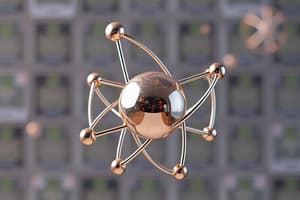Podcast
Questions and Answers
What is the mass number of an isotope that contains 23 protons and 28 neutrons?
What is the mass number of an isotope that contains 23 protons and 28 neutrons?
- 55
- 51 (correct)
- 28
- 23
Which element corresponds to the isotope with 23 protons?
Which element corresponds to the isotope with 23 protons?
- Chromium
- Titanium
- Manganese
- Vanadium (correct)
How many neutrons are present in the silicon isotope with a mass number of 29?
How many neutrons are present in the silicon isotope with a mass number of 29?
- 17
- 16
- 15 (correct)
- 14
What percentage of natural carbon exists as the most abundant isotope?
What percentage of natural carbon exists as the most abundant isotope?
What is the correct relationship between protons and neutrons for the silicon isotope with mass number 28?
What is the correct relationship between protons and neutrons for the silicon isotope with mass number 28?
What charge does an electron possess?
What charge does an electron possess?
Which subatomic particle is found in the nucleus of an atom?
Which subatomic particle is found in the nucleus of an atom?
What is the overall charge of a neutron?
What is the overall charge of a neutron?
What is contained within the nucleus of an atom?
What is contained within the nucleus of an atom?
Which of the following particles is negatively charged?
Which of the following particles is negatively charged?
Which statement best describes the nucleus of an atom?
Which statement best describes the nucleus of an atom?
Which particle has a mass approximately equal to that of a proton?
Which particle has a mass approximately equal to that of a proton?
Which of the following statements is true regarding subatomic particles?
Which of the following statements is true regarding subatomic particles?
What defines an element?
What defines an element?
What does the atomic number of an atom represent?
What does the atomic number of an atom represent?
Which statement is true about isotopes?
Which statement is true about isotopes?
Which of the following statements is false regarding atomic number?
Which of the following statements is false regarding atomic number?
How do isotopes of the same element differ?
How do isotopes of the same element differ?
What is a common characteristic of isotopes of the same element?
What is a common characteristic of isotopes of the same element?
Why do isotopes of an element exhibit slight differences in physical properties?
Why do isotopes of an element exhibit slight differences in physical properties?
Which of the following describes a characteristic of elements found in nature?
Which of the following describes a characteristic of elements found in nature?
What is the significance of an atom being electrically neutral?
What is the significance of an atom being electrically neutral?
Which of the following correctly identifies the subatomic particles of an atom?
Which of the following correctly identifies the subatomic particles of an atom?
What does the atomic number represent in an atom?
What does the atomic number represent in an atom?
Which of the following statements about mass number is true?
Which of the following statements about mass number is true?
If an atom has an atomic number of 7, how many protons does it contain?
If an atom has an atomic number of 7, how many protons does it contain?
In a neutral atom, what is the relationship between the number of electrons and protons?
In a neutral atom, what is the relationship between the number of electrons and protons?
What is the correct mass number notation for an atom with 6 protons and 6 neutrons?
What is the correct mass number notation for an atom with 6 protons and 6 neutrons?
Which statement about neutrons is accurate?
Which statement about neutrons is accurate?
Flashcards are hidden until you start studying
Study Notes
Internal Structure of an Atom
- Atoms consist of subatomic particles: electrons, protons, and neutrons.
- Electrons have a negative charge and are located outside the nucleus.
- Protons carry a positive charge, equal to the electron's charge, and reside in the nucleus.
- Neutrons are neutral, carrying no charge, and are also found in the nucleus.
- The nucleus is the dense center of an atom, containing all protons and neutrons.
Charge Neutrality of an Atom
- Atoms are electrically neutral; the total charge is zero.
- The number of protons equals the number of electrons, balancing the overall charge.
Atomic Number and Mass Number
- Atomic number (Z) defines the number of protons in an atom's nucleus.
- Mass number (A) is the sum of protons and neutrons present in an atom.
- Chemical symbols for elements incorporate mass number and atomic number for reference.
Isotopes and Atomic Masses
- Isotopes are variants of an element with the same number of protons but different numbers of neutrons.
- Though isotopes exhibit identical chemical properties, their physical properties, such as mass, differ.
- For example, silicon has isotopes with mass numbers of 28 and 29, both having 14 protons but differing neutron counts.
Examples of Isotopes
- Isotope X with 23 protons and 28 neutrons has a mass number of 51, identifying it as Vanadium.
- Elements commonly present in nature exist as isotopes, with carbon isotopes being primarily 98.89% carbon-12 and 1.11% carbon-13.
Studying That Suits You
Use AI to generate personalized quizzes and flashcards to suit your learning preferences.




